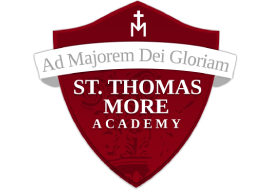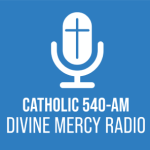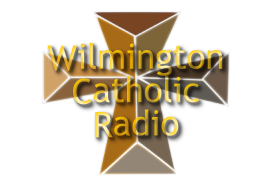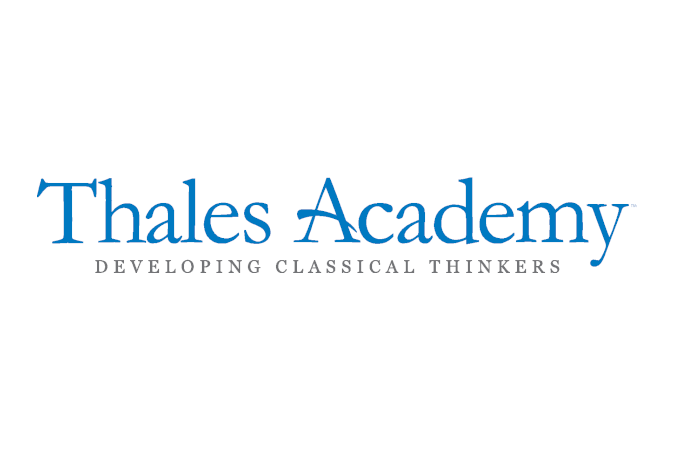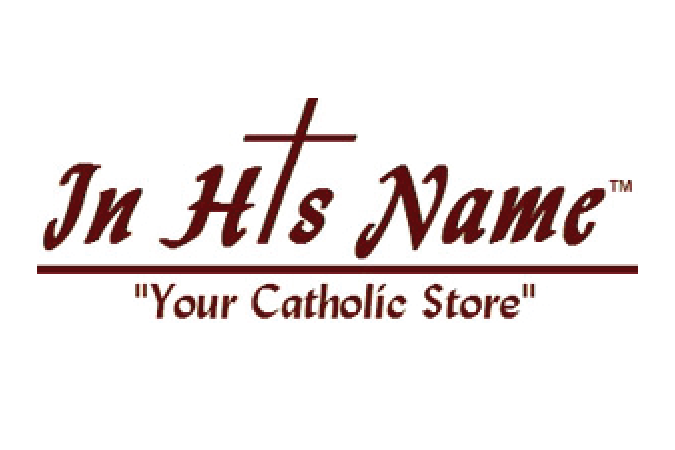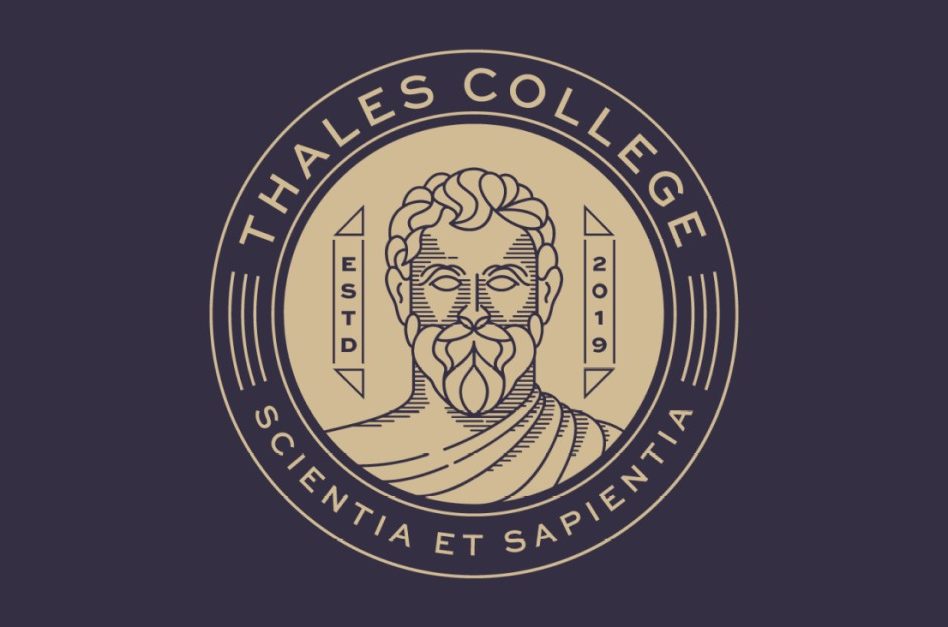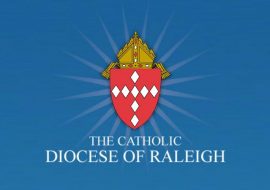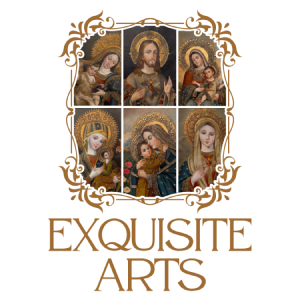My Conference Dashboard
Ignited By Truth Catholic Conference 2025
April 4 - 5, 2025
Thank you to our 2025 Sponsors!
TICKETS
If you haven’t already done so, you can buy your tickets HERE.
We strongly recommend you create an account when you purchase your tickets so you can download your tickets from your My Account page if you lose your tickets and/or your ticket email.
After your purchase, you can download your tickets from the website. Additionally, you’ll receive your tickets via email. If you lose your ticket email, go to your My Account -> Purchased Events page to download your tickets from within your ticket invoice on that page.
If for any reason you need to modify your tickets, you can do so from your My Account -> Purchased Events page. Simply click on the invoice for the tickets you wish to modify, scroll down to the ticket line items, and click Modify Ticket. Remember to click SAVE after you’ve modified your ticket(s).
After you’re finished modifying your tickets, you can download your updated tickets from the same invoice page by clicking the Download Tickets link.
If you’ve already purchased tickets and created an account during your purchase, you can download your tickets from the website at any time.
Simply go to your My Account -> Purchased Events page and click on the invoice for the tickets you wish to download. Scroll down to the ticket linen item(s) and click the Download Tickets link.
HOTEL & CONFERENCE INFORMATION
The 2-Day Conference will be held:
Friday, April 4th – 6:00 – 9:30 PM
Saturday, April 5th – 8:00 AM – 5:30 PM
NC State Reynolds Coliseum
2411 Dunn Ave
Raleigh, NC 27607
Parking Deck
Free parking is available in Reynolds Coliseum Parking Deck, located at 201 Jensen Drive, Raleigh, NC 27601.
Directions to the Parking Deck: From Western Blvd., turn onto Pullen Road, go through the stoplight and turn onto Dunn Ave. The parking decking will be on your left between Jensen Drive and Jeter Drive.
The parking lot between Reynolds Coliseum and the Parking Deck as well as almost all parking on surrounding streets is free on Saturday. There is a drop-off area at the front entrance to the Coliseum on Dunn Avenue.
Main Stage Venue
The Main Stage Program and Vendor & Ministry Fair will be held in William Neal Reynolds Coliseum, located at 2411 Dunn Ave, Raleigh, NC 27606.
Directions to Reynolds Coliseum
Take 1-40 east to exit 295 (Gorman St.). Exit right and turn left at stop light. Go to Avent Ferry Rd. and turn right. The third traffic light is at the intersection of Western Blvd. Go straight through that light (street will become Morrill Dr.) into NC State campus. Continue down Morrill Dr. until you get to a three-way stoplight. Turn right onto Cates Ave. Reynolds Coliseum is on the left.
Friday evening, pizza will be provided for everyone during the Night of Worship.
For Saturday, when you purchase your ticket, you have the option to select Turkey Sub Lunch, Pizza Lunch, or No Lunch (meaning “provide your own”). If you select the “No Lunch” option, you can either bring your own lunch with you, or purchase food and drink from the various vendors in Talley Student Union, which is a building located adjacent to Reynolds Coliseum at 2610 Cates Ave, Raleigh, NC 27606.
To pickup your Lunch Pre-Order at the conference: You can show your order confirmation email by printing it or presenting it on your phone. or Show your bracelet which will identify the lunch option purchased with your ticket if any. |
***Lunch Seating: Inside Talley and the outside Courtyard. A map is below and will be in your program with directions to the Atrium and Hillsborough street. Some people have asked about breakfast after mass. Talley is a good alternative for that.
SCHEDULE & SPEAKERS
Night of Worship
*** Agenda is subject to change. ***
6:00 PM – Venue Opens/Registration/House Music/Vendor & Ministry Fair
6:30 PM – Confessions Begin
6:45 PM – Gathering Music (Dana Catherine)
7:05 PM – Welcome & Introductions with Blessing of the Weekend (Fr. Jason Brooks)
7:25 PM – Dominican Sisters Hello
7:30 PM – Keynote Address (Dan Briggs)
8:15 PM – Song Response & Transition to Adoration (Fr. Jason Brooks & Dana Catherine)
8:20 PM – Eucharistic Adoration with Procession & Benediction (Fr. Jason Brooks & Dana Catherine)
9:35 PM – Wrap up & Announcements (Fr. Jason Brooks)
9:40 PM – Closing Song (Dana Catherine)
The Sacrament of Reconciliation will be available throughout the evening.
Main Conference
*** Agenda is subject to change. ***
7:30 AM – Registration / Vendor & Ministry Fair
8:00 AM – Rosary with Fr. Jason Brooks
8:20 AM – The Veil Removed (video)
8:30 AM – Mass with Fr. Michael Burbeck
Break (when Mass ends)
9:45 AM – Welcome with Fr. Jason Brooks
10:00 AM – Love Heals Heart, Soul, Mind, & Body with Sonja Corbitt
Break (when talk ends)
11:10 AM – Love for the Church & the Healing of our Minds
with Msgr. James Shea
Lunch Break
12:30 PM – Jesus Christ: The Lord of Memory, the Lord of Hope
with Sr. Kraemer & Fr. Jason Brooks
Break (when talk ends)
1:45 PM – Miracles of the Eucharist & Lourdes with Fr. Robert Spitzer
3:00 PM – Eucharistic Procession, Praise & Worship, and
Divine Mercy Chaplet with Fr. Michael Burbeck
Break (when worhip ends)
3:45 PM – Do Not Disturb: The Healing Power of Lenten Silence
with Fr. Augustine Wetta
5:00 PM – Closing with Fr. Jason Brooks
* Confessions will be heard on the second floor behind the stage from 10AM to 4PM
* Eucharistic Adoration will be available throughout the day in Room 104
* Veneration of Relics will be available throughout the day in Room 106
* The Miracles of the Eucharist display will be in the main hall at the top of the stairs
RELICS ON DISPLAY
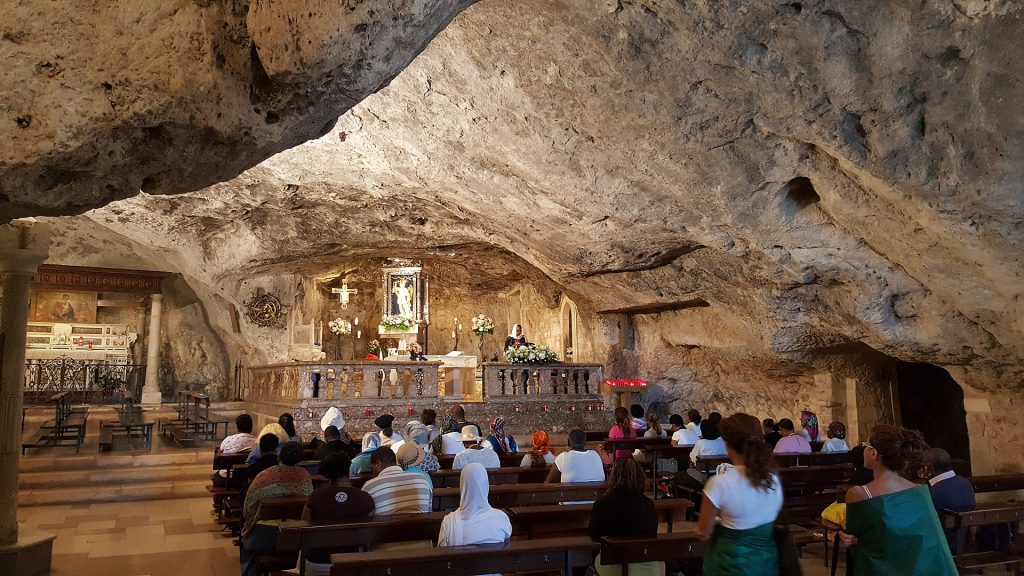
There is a large limestone cave in Gargano, Italy, that was a site of pagan worship in Greek and Roman times. Likely around 490, a wealthy noble named Elvio Emanuele was searching for a bull that had wandered from his herd on the slopes of the mountain. He found it stuck in the entrance to a cave. Angry at the bull for being unmanageable, he tried to have it shot with an arrow by a servant, but somehow the arrow came back and struck the archer himself The noble went to Bishop Maiorano of Sipontum — who was later canonized and is now known as St. Lorenzo Maiorano — and recounted the strange events. The bishop, sensing something supernatural was afoot, ordered three days of prayer and penance.
At the end of the third day, St. Michael appeared to the bishop, saying:
Know ye that this man is so hurt by my will. I am Michael the archangel, which will that this place be worshipped in earth, and will have it surely kept. And therefore I have proved that I am keeper of this place by the demonstrance and showing of this thing.
After this apparition, the people and the bishop made a procession to pray at entrance of the cave. Two years later, likely in 492, the region was attacked by Odoacer and the Christian forces were all but defeated. Bishop Maiorano negotiated a three-day truce with the barbarians, during which the people prayed and did penance. But then St. Michael appeared to the bishop and promised help if they would attack the enemy. During the ensuing battle, a storm of sand and hail broke out that terrified the barbarians, who fled.
Once more the bishop led a procession to the cave to thank St. Michael, but he did not enter, still unwilling to claim the cave for Michael since the place had been considered sacred by local pagans. Bishop Maiorano asked Pope Gelasius I for advice, and the Holy Father told him to occupy the cave and to consecrate it a church.When they arrived to consecrate the cave, Michael appeared to the bishop again. This time, he explained that it was not necessary to consecrate the cave as it had already been consecrated by Michael’s presence. The bishop entered and found an altar covered with a red cloth with a crystal cross on top. He had a church built at the front of the cave and dedicated it to St. Michael on September 29, 493.
And so, at the archangel’s direction, the cave was turned into a church, and it became known throughout the world in a short time. The region took the name of St. Michael, and the sanctuary became one of the four major pilgrimage sites in all of Europe for centuries. St. Francis of Assisi did not feel worthy to enter but prayed for thirty days and nights outside the cave. Later, St. Padre Pio would send people needing deliverance from evil spirits to the cave, and they were healed. The cave has been visited by pilgrims, kings, queens, popes, and saints ever since.
St. Michael Against the Plague
The cave and the sanctuary built out of it returned to prominence in the seventeenth century, when, in 1656, a plague was ravaging Naples and the surrounding countryside. The bishop, Alfonso Puccinelli, pleaded to St. Michael the Archangel for help. At dawn on September 22, after three days of fervent prayer and fasting, St. Michael appeared and promised that those who reverently kept small stones from the cave in their homes and prayed earnestly would be saved from the epidemic. And indeed the words were fulfilled. In memory of this miracle, the bishop erected a statue of St. Michael in front of his palace and added the inscription: “Prince of angels, conqueror of the plague.”
Stones from St. Michael’s cave are still distributed today, both as general sacramentals and as relics, especially to help against the demonic. Many exorcists around the world have used stones from the cave in their rites, with effects similar to those of relics of other saints.
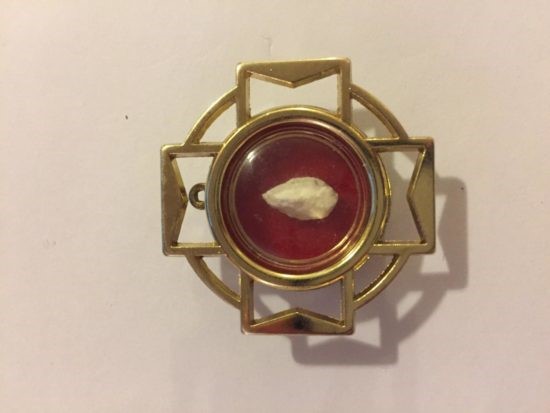
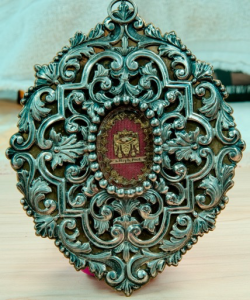 The Holy Protomartyr and Archdeacon Stephen was the eldest of the seven deacons, appointed by the Apostles themselves, and therefore he is called “archdeacon.” He was the first Christian martyr, and he suffered for Christ when he was about thirty. In the words of Asterias, he was “the starting point of the martyrs, the instructor of suffering for Christ, the foundation of righteous confession, since Stephen was the first to shed his blood for the Gospel.”
The Holy Protomartyr and Archdeacon Stephen was the eldest of the seven deacons, appointed by the Apostles themselves, and therefore he is called “archdeacon.” He was the first Christian martyr, and he suffered for Christ when he was about thirty. In the words of Asterias, he was “the starting point of the martyrs, the instructor of suffering for Christ, the foundation of righteous confession, since Stephen was the first to shed his blood for the Gospel.”
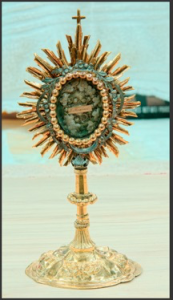 Saint Maximinus – Could be St. Maximin-
Saint Maximinus – Could be St. Maximin-
St Maximin, an early bishop of Aix-en-Provence in southern France. Nothing is really known of his history, not even the years in which he lived, but he became an important figure in the later medieval legend of St Mary Magdalene and her siblings. According to the story, first attested only in the second millennium, when the early Church was “scattered” after the martyrdom of St Stephen (Acts 8), the persecutors set Mary, Martha, Lazarus and many others in a rudderless boat, thinking it would sink and drown them. They were instead brought by divine intervention to the port city of Marseille, of which Lazarus became the first bishop; among their companions were Maximin and Sidonius, the former said by local tradition to have also been the boy whose loaves and fishes were multiplied by Christ (John 6), and the latter said to be the blind man healed in John 9. After years of living a contemplative life in the cave known as the Sainte-Baume (still a popular pilgrimage place to this day), the dying Magdalene received the Viaticum from St Maximin, who then took care of her burial. Learn More…
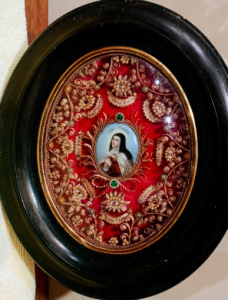 Saint Suaire – Unsure, appears to be associated with Shroud of Turn
Saint Suaire – Unsure, appears to be associated with Shroud of Turn- Saint Joseph – Joseph was the husband of Mary, and the legal father of Jesus Christ, the Savior of the world. While he was not Jesus’ biological father, he played an instrumental role in the birth and upbringing of Jesus. Joseph’s lineage can be traced back all the way to the house of King David. He is mentioned in the early parts of the gospels of Matthew and Luke and lesser in John’s gospel. The Universal Catholic Church later named him the patron of the church. Learn More…
- Saint Anne – Tradition refers to St. Anne as being the mother of the Virgin Mary. Although not written of in the Bible, Anne is given credence in the non-biblical gospel of James. She was born in Bethlehem and married Joachim from Nazareth in Galilee. Joachim was a shepherd given the task of supplying the temple of Jerusalem with sheep for sacrifices. Learn More…
- Saint Clemence – Clement of Rome was the third successor of Saint Peter, reigning as pope during the last decade of the first century. He’s known as one of the Church’s five “Apostolic Fathers,” those who provided a direct link between the Apostles and later generations of Church Fathers. Learn More…
- Saint Veronica – Saint Veronica is known as the woman who offered a cloth to Jesus so He could wipe His face on the way to His crucifixion. The cloth is believed to exist today in the Vatican and is considered one of the most treasured relics of the Church. Saint Veronica is not mentioned in the Bible, but is known to us by Catholic tradition and in the Sixth Station of the Cross, “Veronica Wipes the Face of Jesus.” Learn More…
- Saint Felix – Felix was the son of Hermias, a Syrian who had been a Roman soldier. He was born on his father’s estate at Nola near Naples, Italy. On the death of his father, Felix distributed his inheritance to the poor, was ordained by Bishop St. Maximus of Nola, and became his assistant. When Maximus fled to the desert at the beginning of Decius’ persecution of the Christians in 250, Felix was seized in his stead and imprisoned. He was reputedly released from prison by an angel, who directed him to the ailing Maximus, whom he brought back to Nola. Learn More…
- V. de La Sainte Vierge – Unclear, some reference this as being Mary, the mother of Jesus.
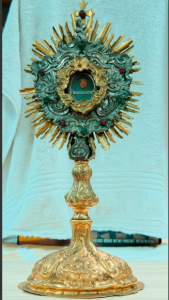 Saint Martha Virg – “Jesus loved Martha and Mary and Lazarus.” This unique statement in John’s gospel tells us of the special relationship Jesus had with Martha, her sister, and her brother. Apparently Jesus was a frequent guest at Martha’s home in Bethany, a small village two miles from Jerusalem. We read of three visits in Luke 10:38-42, John 11:1-53, and John 12:1-9. Many of us find it easy to identify with Martha in the story Luke tells. Martha welcomes Jesus and his disciples into her home and immediately goes to work to serve them. Hospitality is paramount in the Middle East and Martha believed in its importance. Imagine her frustration when her sister Mary ignores the rule of hospitality and Martha’s work in order to sit and listen to Jesus. Instead of speaking to her sister, she asks Jesus to intervene. Jesus’ response is not unkind, which gives us an idea of his affection for her. He observes that Martha is worried about many things that distract her from really being present to him. He reminds her that there is only one thing that is truly important — listening to him. And that is what Mary has done.
Saint Martha Virg – “Jesus loved Martha and Mary and Lazarus.” This unique statement in John’s gospel tells us of the special relationship Jesus had with Martha, her sister, and her brother. Apparently Jesus was a frequent guest at Martha’s home in Bethany, a small village two miles from Jerusalem. We read of three visits in Luke 10:38-42, John 11:1-53, and John 12:1-9. Many of us find it easy to identify with Martha in the story Luke tells. Martha welcomes Jesus and his disciples into her home and immediately goes to work to serve them. Hospitality is paramount in the Middle East and Martha believed in its importance. Imagine her frustration when her sister Mary ignores the rule of hospitality and Martha’s work in order to sit and listen to Jesus. Instead of speaking to her sister, she asks Jesus to intervene. Jesus’ response is not unkind, which gives us an idea of his affection for her. He observes that Martha is worried about many things that distract her from really being present to him. He reminds her that there is only one thing that is truly important — listening to him. And that is what Mary has done.
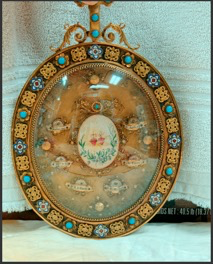 Saint Maximi – (St Maximin), an early bishop of Aix-en-Provence in southern France. Nothing is really known of his history, not even the years in which he lived, but he became an important figure in the later medieval legend of St Mary Magdalene and her siblings. According to the story, first attested only in the second millennium, when the early Church was “scattered” after the martyrdom of St Stephen (Acts 8), the persecutors set Mary, Martha, Lazarus and many others in a rudderless boat, thinking it would sink and drown them. They were instead brought by divine intervention to the port city of Marseille, of which Lazarus became the first bishop; among their companions were Maximin and Sidonius, the former said by local tradition to have also been the boy whose loaves and fishes were multiplied by Christ (John 6), and the latter said to be the blind man healed in John 9. After years of living a contemplative life in the cave known as the Sainte-Baume (still a popular pilgrimage place to this day), the dying Magdalene received the Viaticum from St Maximin, who then took care of her burial. – Could also be Saint Maxiinus. Learn More…
Saint Maximi – (St Maximin), an early bishop of Aix-en-Provence in southern France. Nothing is really known of his history, not even the years in which he lived, but he became an important figure in the later medieval legend of St Mary Magdalene and her siblings. According to the story, first attested only in the second millennium, when the early Church was “scattered” after the martyrdom of St Stephen (Acts 8), the persecutors set Mary, Martha, Lazarus and many others in a rudderless boat, thinking it would sink and drown them. They were instead brought by divine intervention to the port city of Marseille, of which Lazarus became the first bishop; among their companions were Maximin and Sidonius, the former said by local tradition to have also been the boy whose loaves and fishes were multiplied by Christ (John 6), and the latter said to be the blind man healed in John 9. After years of living a contemplative life in the cave known as the Sainte-Baume (still a popular pilgrimage place to this day), the dying Magdalene received the Viaticum from St Maximin, who then took care of her burial. – Could also be Saint Maxiinus. Learn More…
St. Agnes – St. Agnes of Rome was born in 291 AD and raised in a Christian family. Agnes was very beautiful and belonged to a wealthy family. Her hand in marriage was highly sought after, and she had many high ranking men chasing after her. However, Agnes made a promise to God never to stain her purity. Her love for the Lord was great and she hated sin even more than death! – Whenever a man wished to marry Agnes, she would always say, “Jesus Christ is my only Spouse.” Learn More…
St. Charles – (Borromeo) The name of Charles Borromeo is associated with reform. He lived during the time of the Protestant Reformation, and had a hand in the reform of the whole Church during the final years of the Council of Trent. Although he belonged to the Milanese nobility and was related to the powerful Medici family, Charles desired to devote himself to the Church. In 1559, when his uncle, Cardinal de Medici was elected Pope Pius IV, he made Charles cardinal-deacon and administrator of the Archdiocese of Milan. At the time Charles was still a layman and a young student. Because of his intellectual qualities Charles was entrusted with several important offices connected with the Vatican, and later appointed secretary of state with responsibility for the papal states. The untimely death of his elder brother brought Charles to a definite decision to be ordained a priest, despite his relatives’ insistence that he marry. Soon after being ordained a priest at age 25, Borromeo was consecrated bishop of Milan. Learn More…
St. Louis de Sales – St. Francis de Sales was born to a noble family at Chateau de Sales in the Kingdom of Savoy near Geneva, Switzerland on August 21, 1567. He was a Bishop and Doctor of the Church. Francis was both intelligent and gentle. From a very early age, he desired to serve God. He knew for years he had a vocation to the priesthood, but kept it from his family. His father wanted him to enter a career in law and politics. In 1580, Francis attended the University of Paris, and at 24-years-old, he received his doctorate in law at the University of Padua. Learn More…
St. Jane de Chantal – “In Madame de Chantal I have found the perfect woman, whom Solomon had difficulty finding in Jerusalem”. – St. Francis de Sales, her spiritual director. St. Jane Frances de Chantal was born in Dijon, France, on January 28, 1572, and died at the Visitation Convent Moulins on December 13, 1641. Jane (Jeanne) was born into nobility, her father being the president of the parliament of Burgundy. At age 20 she was married to the Baron de Chantal. Jane had four children, and loved and served her young family deeply until the death of her husband in a hunting accident at age 28. For seven years she was forced to live in the house of her father in law, a trial which she was forced to bare patiently due to his ill-disposition towards her, and it was during this time that she took a vow of perpetual chastity. Learn More…
St. Margaret Mary Alacoque – St. Margaret Mary Alacoque, a French Roman Catholic Visitation nun and mystic, is greatly recognized for her devotion to the Sacred Heart of Jesus. She was born in 1647 in France as the only daughter of Claude and Philiberte Lamyn Alacoque. Margaret has always shown an intense love for the Blessed Sacrament and preferred silence over typical childhood play. She began practicing severe corporal mortification after her first communion at 9-years-old. She continued this until rheumatic fever confined her to her bed for four years. After making a vow to the Blessed Virgin Mary to consecrate herself to religious life, Margaret instantly returned to perfect health. In recognition of this favor, Margaret added the name Mary to her baptismal name. Learn More…
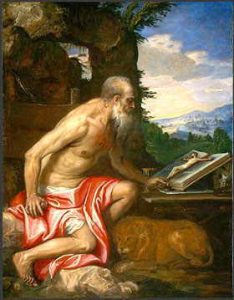 Saint Jerome – Before he was known as Saint Jerome, he was named Eusebius Sophronius Hieronymus. He was born around 342 AD, in Stridon, Dalmatia. Today, the town, which ceased to exist in Jerome’s time, would likely be in Croatia or Slovenia. The young Jerome was educated by Aelius Donatus, who was a famous Roman grammarian. From him, the young Jerome learned Latin and Greek. Little else is known of his childhood other than his parents were probably well-to-do and Christian. Despite their efforts to raise Jerome properly, the young man behaved as he chose.
Saint Jerome – Before he was known as Saint Jerome, he was named Eusebius Sophronius Hieronymus. He was born around 342 AD, in Stridon, Dalmatia. Today, the town, which ceased to exist in Jerome’s time, would likely be in Croatia or Slovenia. The young Jerome was educated by Aelius Donatus, who was a famous Roman grammarian. From him, the young Jerome learned Latin and Greek. Little else is known of his childhood other than his parents were probably well-to-do and Christian. Despite their efforts to raise Jerome properly, the young man behaved as he chose.
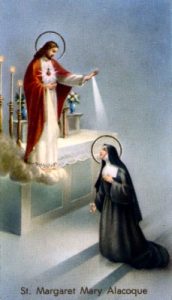 Saint Mary Alacoque – St. Margaret Mary Alacoque, a French Roman Catholic Visitation nun and mystic, is greatly recognized for her devotion to the Sacred Heart of Jesus. She was born in 1647 in France as the only daughter of Claude and Philiberte Lamyn Alacoque. Margaret has always shown an intense love for the Blessed Sacrament and preferred silence over typical childhood play. She began practicing severe corporal mortification after her first communion at 9-years-old. She continued this until rheumatic fever confined her to her bed for four years. After making a vow to the Blessed Virgin Mary to consecrate herself to religious life, Margaret instantly returned to perfect health. In recognition of this favor, Margaret added the name Mary to her baptismal name.
Saint Mary Alacoque – St. Margaret Mary Alacoque, a French Roman Catholic Visitation nun and mystic, is greatly recognized for her devotion to the Sacred Heart of Jesus. She was born in 1647 in France as the only daughter of Claude and Philiberte Lamyn Alacoque. Margaret has always shown an intense love for the Blessed Sacrament and preferred silence over typical childhood play. She began practicing severe corporal mortification after her first communion at 9-years-old. She continued this until rheumatic fever confined her to her bed for four years. After making a vow to the Blessed Virgin Mary to consecrate herself to religious life, Margaret instantly returned to perfect health. In recognition of this favor, Margaret added the name Mary to her baptismal name.
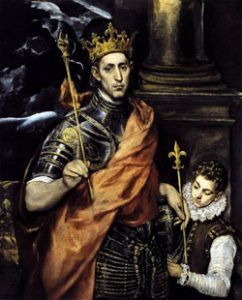 Saint Louis de France – St. Louis, King of France, patron of Tertiaries, was the ninth of his name. He was born at Poissy, France, in 1214. His father was Louis VIII, and his mother was Blanche, daughter of Alfonso VIII of Castille, surnamed the Conqueror. At the age of twelve he lost his father, and his mother became regent of the kingdom. From his tenderest infancy she had inspired him with a love for holy things.
Saint Louis de France – St. Louis, King of France, patron of Tertiaries, was the ninth of his name. He was born at Poissy, France, in 1214. His father was Louis VIII, and his mother was Blanche, daughter of Alfonso VIII of Castille, surnamed the Conqueror. At the age of twelve he lost his father, and his mother became regent of the kingdom. From his tenderest infancy she had inspired him with a love for holy things.
In 1234, he married Margaret, the virtuous daughter of Raymond Berenger, Count of Provence, and two years later he took the reigns of government into his own hands. In 1238, he headed a crusade, in which he fell a prisoner among the Mohammedans, but a truce was concluded and he was set free and he returned to France. In 1267, he again set out for the East at the head of a crusade but he never again beheld his native land. In 1270, he was stricken by the pestilence at the siege of Tunis, and after receiving the Last Sacraments, he died. His feast day is August 25th.
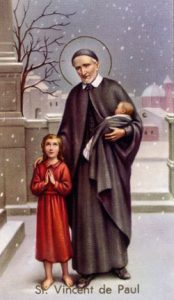 Saint Vincent de Paul – St. Vincent de Paul was born to a poor peasant family in the French village of Pouy on April 24, 1581. His first formal education was provided by the Franciscans. He did so well, he was hired to tutor the children of a nearby wealthy family. He used the monies he earned teaching to continue his formal studies at the University of Toulose where he studied theology. He was ordained in 1600 and remained in Toulose for a time. In 1605, while on a ship traveling from Marseilles to Narbone, he was captured, brought to Tunis and sold as a slave. Two years later he and his master managed to escape and both returned to France. St. Vincent went to Avignon and later to Rome to continue his studies. While there he became a chaplain to the Count of Goigny and was placed in charge of distributing money to the deserving poor. He became pastor of a small parish in Clichy for a short period of time, while also serving as a tutor and spiritual director.
Saint Vincent de Paul – St. Vincent de Paul was born to a poor peasant family in the French village of Pouy on April 24, 1581. His first formal education was provided by the Franciscans. He did so well, he was hired to tutor the children of a nearby wealthy family. He used the monies he earned teaching to continue his formal studies at the University of Toulose where he studied theology. He was ordained in 1600 and remained in Toulose for a time. In 1605, while on a ship traveling from Marseilles to Narbone, he was captured, brought to Tunis and sold as a slave. Two years later he and his master managed to escape and both returned to France. St. Vincent went to Avignon and later to Rome to continue his studies. While there he became a chaplain to the Count of Goigny and was placed in charge of distributing money to the deserving poor. He became pastor of a small parish in Clichy for a short period of time, while also serving as a tutor and spiritual director.
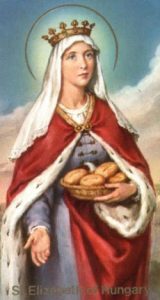 Saint Elizabeth of Hungary – St. Elizabeth of Hungary, also known as St. Elizabeth of Thuringia, was born in Hungary on July 7, 1207 to the Hungarian King Andrew II and Gertrude of Merania. As soon as her life began, she had responsibilities from being a royal pressed upon her. While Elizabeth was very young, her father arranged for her to be married to Ludwig IV of Thuringia, a German nobleman. Because of this plan, Elizabeth was sent away at the age of four for education at the court of the Landgrave of Thuringia. Elizabeth’s mother, Gertrude, was murdered in 1213, when Elizabeth was just six-years-old. According to history, the murder was carried out by Hungarian noblemen due to the conflict between Germans and the Hungarian nobles. From this point on, Elizabeth’s perspective on life and death dramatically changed and she sought peace with prayer.
Saint Elizabeth of Hungary – St. Elizabeth of Hungary, also known as St. Elizabeth of Thuringia, was born in Hungary on July 7, 1207 to the Hungarian King Andrew II and Gertrude of Merania. As soon as her life began, she had responsibilities from being a royal pressed upon her. While Elizabeth was very young, her father arranged for her to be married to Ludwig IV of Thuringia, a German nobleman. Because of this plan, Elizabeth was sent away at the age of four for education at the court of the Landgrave of Thuringia. Elizabeth’s mother, Gertrude, was murdered in 1213, when Elizabeth was just six-years-old. According to history, the murder was carried out by Hungarian noblemen due to the conflict between Germans and the Hungarian nobles. From this point on, Elizabeth’s perspective on life and death dramatically changed and she sought peace with prayer.
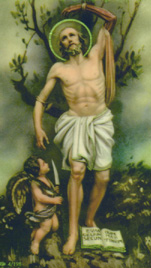 Saint Bartholomew the Apostle – St. Bartholomew, 1st. century, one of the 12. All that is known of him with certainty is that he is mentioned in the synoptic gospels and Acts as one of the twelve apostles. His name, a patronymic, means “son of Tolomai” and scholars believe he is the same as Nathanael mentioned in John, who says he is from Cana and that Jesus called him an “Israelite…incapable of deceit.” The Roman Martyrology says he preached in India and Greater Armenia, where he was flayed and beheaded by King Astyages. Tradition has the place as Abanopolis on the west coast of the Caspian Sea and that he also preached in Mesopotamia, Persia, and Egypt. The Gospel of Bartholomew is apochryphal and was condemned in the decree of Pseudo-Gelasius. Feast Day August 24.
Saint Bartholomew the Apostle – St. Bartholomew, 1st. century, one of the 12. All that is known of him with certainty is that he is mentioned in the synoptic gospels and Acts as one of the twelve apostles. His name, a patronymic, means “son of Tolomai” and scholars believe he is the same as Nathanael mentioned in John, who says he is from Cana and that Jesus called him an “Israelite…incapable of deceit.” The Roman Martyrology says he preached in India and Greater Armenia, where he was flayed and beheaded by King Astyages. Tradition has the place as Abanopolis on the west coast of the Caspian Sea and that he also preached in Mesopotamia, Persia, and Egypt. The Gospel of Bartholomew is apochryphal and was condemned in the decree of Pseudo-Gelasius. Feast Day August 24.
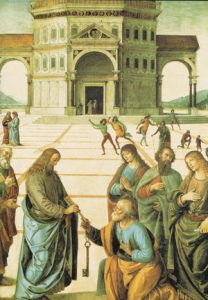 Saint Peter – Peter, who was also known as Simon Peter of Cephas, is considered the first Pope. Despite his papacy, Peter had humble beginnings and became one of the Twelve Apostles of Jesus. He was ordained by Jesus in the “Rock of My Church” written in Matthew 16:17-18, which says, “Jesus replied, ‘Simon son of Jonah, you are a blessed man! Because it was no human agency that revealed this to you but my Father in heaven. So I now say to you: You are Peter and on this rock I will build my community. And the gates of the underworld can never overpower it.'” Peter was a native of Bethsaida, near Lake Tiberias and was the son of Jonah. He and his brother Andrew were fishermen on Lake Genesareth.
Saint Peter – Peter, who was also known as Simon Peter of Cephas, is considered the first Pope. Despite his papacy, Peter had humble beginnings and became one of the Twelve Apostles of Jesus. He was ordained by Jesus in the “Rock of My Church” written in Matthew 16:17-18, which says, “Jesus replied, ‘Simon son of Jonah, you are a blessed man! Because it was no human agency that revealed this to you but my Father in heaven. So I now say to you: You are Peter and on this rock I will build my community. And the gates of the underworld can never overpower it.'” Peter was a native of Bethsaida, near Lake Tiberias and was the son of Jonah. He and his brother Andrew were fishermen on Lake Genesareth.
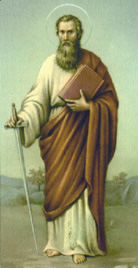 Saint Paul – Saint Paul is one of the most important and influential of all the saints. Many of his writings are contained in the Canon of the Bible and have influenced the growth and development of the Church since the first century. St. Paul was originally known as Saul, and he was a Roman citizen and a Pharisee. He even presided over the persecutions of the early Christians and was present at the martyrdom of St. Stephen. However, Saul experienced a powerful vision that caused him to convert to Christianity while on the road to Damascus. He was duly baptized and took the name Paul. Paul traveled the world, first to Arabia then back to Damascus. He also visited Jerusalem to see St. Peter, the first pope and pay homage to him. During these travels, he preached ceaselessly, often drawing criticism and ire from those who rebuffed his message. Jews, in particular, hated his preaching as they saw him convert people to Christianity from Judaism.
Saint Paul – Saint Paul is one of the most important and influential of all the saints. Many of his writings are contained in the Canon of the Bible and have influenced the growth and development of the Church since the first century. St. Paul was originally known as Saul, and he was a Roman citizen and a Pharisee. He even presided over the persecutions of the early Christians and was present at the martyrdom of St. Stephen. However, Saul experienced a powerful vision that caused him to convert to Christianity while on the road to Damascus. He was duly baptized and took the name Paul. Paul traveled the world, first to Arabia then back to Damascus. He also visited Jerusalem to see St. Peter, the first pope and pay homage to him. During these travels, he preached ceaselessly, often drawing criticism and ire from those who rebuffed his message. Jews, in particular, hated his preaching as they saw him convert people to Christianity from Judaism.
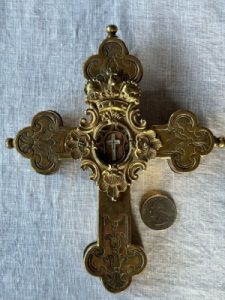 The Cross to which Christ had been nailed, and on which He had died, became for Christians, quite naturally and logically, the object of a special respect and worship. St. Paul says, in 1 Corinthians 1:17 : “For Christ sent me not to baptize ; but to preach the gospel : not in wisdom of speech, lest the cross of Christ should be made void”; in Galatians 2:19 : “With Christ I am nailed to the cross”; in Ephesians 2:16 : Christ . . . . “might reconcile both to God in one body by the cross”; in Philippians 3:18 : “For many walk . . . enemies of the cross of Christ”; in Colossians 2:14 : “Blotting out the handwriting of the decree that was against us, which was contrary to us. And he hath taken the same out of the way, fastening it to the cross”; and in Galatians 6:14 : “But God forbid that I should glory, save in the cross of our Lord Jesus Christ ; by whom the world is crucified to me, and I to the world”.
The Cross to which Christ had been nailed, and on which He had died, became for Christians, quite naturally and logically, the object of a special respect and worship. St. Paul says, in 1 Corinthians 1:17 : “For Christ sent me not to baptize ; but to preach the gospel : not in wisdom of speech, lest the cross of Christ should be made void”; in Galatians 2:19 : “With Christ I am nailed to the cross”; in Ephesians 2:16 : Christ . . . . “might reconcile both to God in one body by the cross”; in Philippians 3:18 : “For many walk . . . enemies of the cross of Christ”; in Colossians 2:14 : “Blotting out the handwriting of the decree that was against us, which was contrary to us. And he hath taken the same out of the way, fastening it to the cross”; and in Galatians 6:14 : “But God forbid that I should glory, save in the cross of our Lord Jesus Christ ; by whom the world is crucified to me, and I to the world”.
Frequently Asked Questions
Yes, the second level of the coliseum will have seating for social distancing.
Yes, go to the Main Stage before Mass begins to request a Gluten-Free host.
Search for the subject, “Your tickets from Ignited by Truth”. You may either display your tickets on your phone or print and bring them with you.
Remember that if you created an account on our website when you purchased your tickets, you can download your tickets here.
If, for any reason, you’re not able to locate or download your tickets, we can look up your registration at the door.
Yes, we are having a Night of Worship event on Friday evening. You can see the agenda for that by clicking here.
Registration is required.
You will need to show your tickets to check-in at the event. Be prepared by pulling them up on your phone or print the emailed tickets you received. If you can’t find your tickets, we can look up your registration at the door.
See the section above on Hotel & Conference Information for directions & parking.
In addition to an order confirmation, your ticket will arrive by e-mail. Sometimes the system takes a few minutes to send the e-mail.
Remember that if you created an account on our website when you purchased your tickets, you can download your tickets here.
If, for any reason, you’re not able to locate or download your tickets, we can look up your registration at the door. You will receive a reminder e-mail within one week before the conference.
The word catholic means “universal”. The truths proclaimed at the conference are light for all people.
Ignited By Truth is a wonderful opportunity to come back! You will experience a sense of community sitting side-by-side with the other attendees as all of us together rediscover the gift of our Faith.
Inviting your loved one to come with you is the best way! If you have been to a past IBT conference, you could explain why you liked it. If you are excited about this year’s speakers, share what you know about them. Consider what you could do to make it possible for this person to come. Could you pay admission? Arrange childcare? Give a ride? Do what you can and leave it in God’s hands.
Email envoys@IgnitedByTruth.org and we will advise you and provide all the materials you need!
There are many possibilities:
- Your spouse could attend part of the conference, and you could attend the rest.
- Pair up with another couple who also needs childcare and split the cost of a babysitter or trade off babysitting during the day.
- Arrange play dates for your children with their friends or cousins.
- Invite one of your parents to visit with their grandchildren for the day.
Should you be unable to attend, please consider offering your admission to a friend or as a tax-deductible gift. If there is a financial hardship, we do have the ability to process a refund.
Ignited By Truth is a 501(c)(3) organization supported by the Catholic Diocese of Raleigh, NC.
Yes, and doing this will allow you more time to browse the vendor and ministry tables.
Yes, Talley Student Union is adjacent to Reynolds Coliseum and has a variety of food vendors.
https://dining.ncsu.edu/location/talley-pavilions/
For fastest service, please download the “Tapingo” phone app which allows pre-ordering.
Clark Dining Hall is also within walking distance at 221 Jensen Drive just beyond the parking deck (https://dining.ncsu.edu/location/clark/).
No! The discount is available individually with advance registration. There is no need to create a group. Please register online while tickets are still available.
Reynolds Coliseum has convenient parking and partial handicap (ADA) accessibility. Assistance for elderly and handicapped is provided by volunteers. There will be many chairs on the floor of the coliseum to enable easy access to seating.
Yes! The Ignited By Truth Conference is accepted by the Diocese of Raleigh towards continuing certification and education. 0.6 CEUs are being offered for attendance.

